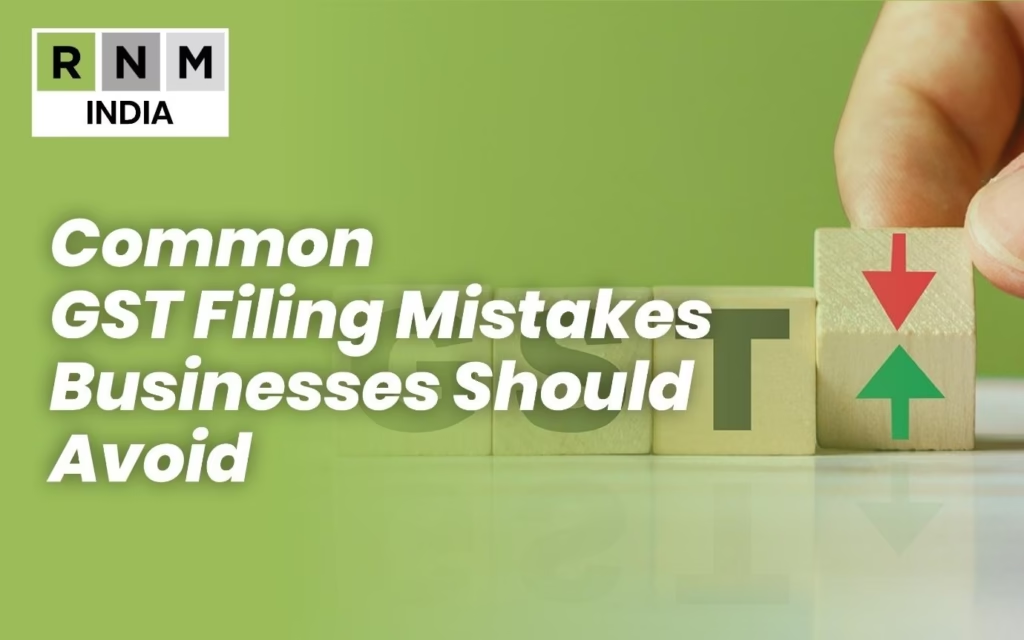Goods and Services Tax or GST has become a significant aspect of the business operations of the present time. All business small and large will be required to submit GST returns on time and with appropriate information. However, there are still numerous businesses that commit minor and significant errors when submitting their GST returns. Such errors may seem innocent, yet they can cause fines, interest, notices and even compliance issues in the long run.
GST filing should not be viewed merely as a monthly activity, as it significantly impacts your business documentation and tax management. GST filing can make a business remain in an organised stress-free mode when done properly. When applied wrongly, it may cause confusion and avoidable issues. That is why all businesses should be aware of the typical GST filing errors and prevention of these errors. The better you are aware the easier your filing will be.
This blog describes the most frequent GST filing errors. Every point is stated in simple words which will be understood even by the child. It is aimed at assisting you to learn, prevent mistakes, and maintain your business safe and legal.
Introduction
The filing of GST is the procedure of filing monthly or quarterly returns that depict your sales, purchases, tax paid and the amount of tax collected. Most companies commit errors during the input of information or handling of documents. Examples of such errors are erroneous entries, delayed filing or missing documents. Every mistake may lead to problems in the future.
Failure in filing GST wrongly or incompletely can result in:
• Punishment in case of non-submission.
• Interest on unpaid tax
• GST notices
• Blocking of the Input Tax Credit (ITC)
• Mismatch issues on books and the GST portal
|human|>Mismatch with the GST portal and business books.
To prevent such issues, companies should be cautious and modern. In case the GST returns are correctly filled, the business will be safe, clean and compliant. Then, we are going to see what are the most typical errors that should be avoided.
Mistake 1: Incorrect or Incomplete GST Information
The wrong information is one of the most prevalent errors in the GST filing. A lot of companies key in information in a major rush and this contributes to grave mistakes.
The following are some of the common problems:
• Incorrect GSTIN
• Incorrect invoice number or value of invoice
• Incorrect HSN or SAC codes
• Missing invoice details
• Errors in tax calculation
A single error will impact on your GST return, since all the information in the GST portal will be matched with sales and purchase. ITC can be mismatched, notified, or rejected using wrong information.
This is a simple error that can be prevented by verification of invoices, GSTIN, and values prior to filing. Make sure your data is always clean and updated to avoid the problems in the future.
Mistake 2: Missing GST Return Deadlines
The due dates of GST returns are set. It has returns to be filed monthly and quarterly. The failure to meet these due dates could lead to:
• Late fees
• Interest on tax
• Poor compliance rating
• Problem submitting returns in the future
Most companies miss payment dates as they have a lot of work or sometime they file at the very last time. The portal can also be slow when the deadline runs out, thus raising the risk of errors.
The most effective method of eliminating such error is to put reminders. Early filing also leads to less stress and last-minute errors are avoided.
Mistake 3: Incorrect Input Tax Credit (ITC) Claims
Input Tax Credit is highly beneficial to businesses since it lowers the amount of tax business has to pay. However, a lot of enterprises err when presenting ITC. Others claim ITC on bills not qualifying or they fail to claim ITC due to ineffective records.
ITC claims occur wrongly due to:
• Missing invoices
• Vendor not filing returns
• Deduction of ITC of personal expenses
• Claiming ITC on services and goods which are not eligible
To prevent incorrect ITC or ineligible claims of credit, numerous companies use professional tax preparation services that allow them to keep the records accurate and guaranteeing a hassle-free GST compliance.
When ITC is asserted in the right way it saves money and guards the business against notices and fines.
Mistake 4: Not Reconciling Books With GST Portal
Reconciliation entails the process of verifying whether the numbers in your business accounts are the same as the ones in the GST portal. Most companies do not take this step and it later leads to huge mismatches.
Problems that are common during the reconciliation process are:
• Missing purchase invoices
• Failure of vendor to post invoices
• Different book amount and portal amount of taxable
• Supplier wrong tax rate
Considerable reconciliation, particularly with the review of the top audit firms in india, assists the businesses in detecting the mismatches in time and adhering to the correct GST filings.
Reconciliation should either be done monthly or at least prior to submission of GSTR-3B and GSTR-1. It conserves time, minimizes errors, and makes ITC clean.
Mistake 5: Wrong GST Rate or HSN/SAC Classification
There are various tax rates in GST depending on the products and services. Such rates are based on adequate HSN or SAC classification. The reason why many businesses decide on the wrong GST rate is due to the confusion on the classification of which product falls in which category.
Examples of errors are:
• Applying 12 percent rate as opposed to 18 percent
• Incorrect HSN code for goods
• Wrong SAC code for services
• Putting goods having similar names in the wrong categories
The misuse of the rate might result in under-payment or over-payment of tax. The under-payment results in interest and notices. Excessive payment leads to the loss of money.
To prevent it, it is necessary to always check updated lists of GST rates and verify the HSN/SAC codes prior to filing.
Mistake 6: Filing GST Returns Without Proper Review
Most companies submit their GST returns in haste. They are in a rush to file GSTR-1 or GSTR-3B without verifying the information. This leads to:
• Wrong sales values
• Missing invoices
• Incorrect ITC
• Duplicate entries
• Different data on GSTR-1 and GSTR-3B
When a GST return has been filed, the same cannot be revised easily. The only solution to mistakes is to review your return prior to submitting it. The only thing that will save much in the future is spending a few additional minutes before looking into details.
Mistake 7: Ignoring GST Notices and Mismatch Reports
The GST department issues notices in cases of differences, errors, and missing information. Most companies disregard such reminders due to being pressured or disoriented. However, one should not disregard a GST notice.
Mismatch notices can be found when:
• Supplier does not make returns
• The ITC purported exceeds the limit
• Sales made in GSTR-3B and GSTR-1 are not matching
• Wrong values are found in the annual return
It is quite essential to respond to notices punctually. Effective response can assist in closing the problem promptly and protect the business against the fines.
How to Avoid These GST Filing Mistakes
Most of the GST errors that businesses commit can be prevented by remaining tidy and asking assistance where necessary. A few good practices include:
• Maintaining records of purchase and sales
• Checking invoices including them
• Making returns in time
• Checking GST return in detail and submitting it
• Conducting monthly reconciliation
• Keeping up with the changes in the GST rules
To facilitate easy completion of monthly filings and avoid repeated mistakes, companies usually engage the professional gst consultancy services that do end-to-end documentation, reconciliation and compliance.
Professional assistance is less stressful and provides the company with more opportunity to work and develop.
Conclusion
It is relevant that every business avoids GST filing errors. Minor mistakes can lead to major issues, such as fines, warnings, and mismatches. With the right GST filing, your business will remain clean, safe and in a position to grow.
Most of the GST issues can be avoided by ensuring that you remain organised, file your filing on time, and that you check your details twice. The GST practices are organized and easy to comply with, and safeguard the company against future risk.
FAQs
1. What are the most frequent errors in filing GST?
The mistakes are some wrong GSTIN, incorrect details of invoice, late filing, incorrect ITC claims, and mismatched returns.
2. What can I do to prevent GST returns errors?
Make proper records, reconcile monthly, file on time, and review your return and then submit it.
3. How shall I act in the case of a GST mismatch or notice?
Be careful of the notice, and reply promptly. Fix the discrepancy and revise your documentation so as to avoid problems in future.






